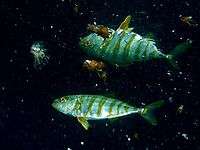Japanese amberjack
| Japanese amberjack | |
|---|---|
.jpg) | |
| Japanese amberjack (Seriola quinqueradiata) | |
| Scientific classification | |
| Kingdom: | Animalia |
| Phylum: | Chordata |
| Class: | Actinopterygii |
| Order: | Perciformes |
| Family: | Carangidae |
| Genus: | Seriola |
| Species: | S. quinqueradiata |
| Binomial name | |
| Seriola quinqueradiata Temminck & Schlegel, 1845 | |
The Japanese amberjack or yellowtail, Seriola quinqueradiata, is a species of jack fish in the family Carangidae. It is native to the northwest Pacific Ocean, from Japan to Hawaii.
It is greatly appreciated in Japan, where it is called hamachi or buri (鰤). They are eaten either cooked or raw, and are a seasonal favourite in the colder months when the meat has higher fat content. Amberjack is typically thought of as a winter delicacy of Toyama and the Hokuriku region. Although it is frequently listed on menus as "Yellowtail tuna", it is a fish of an entirely different family, the Carangidae, rather than the Scombridae family that includes tunas, mackerels, and bonitos.[1]
Some of the fish consumed are caught wild, but a substantial amount is farmed (about 120,000 tonnes per year). To populate the farms, every May, farmers fish for the small wild fry (called mojako), which can be found under floating seaweed. They scoop out the seaweed together with the mojako and put the mojako in cages in the sea.[2]
The small fry grow until they reach 10 to 50 grams in mass; the fry are called inada in eastern Japan (Kantō). They are then sold to farmers, who grow them until they reach 3 kilograms called hamachi, or 5 kilograms called buri. These days, most farmers use extruded pellets to feed the fish.
 Japanese amberjack (juvenile form)
Japanese amberjack (juvenile form) Soup with Japanese amberjack, Japanese: 鰤の吸物
Soup with Japanese amberjack, Japanese: 鰤の吸物
References
- ↑ Casson Trenor (January 2009). Sustainable Sushi: A Guide to Saving the Oceans One Bite at a Time. North Atlantic Books. pp. 6–. ISBN 978-1-55643-769-4.
- ↑ "Yellowtail". Encyclopedia of Japan. Tokyo: Shogakukan. 2012. OCLC 56431036. Retrieved 2012-08-23.
- "Seriola quinqueradiata". Integrated Taxonomic Information System. Retrieved 18 April 2006.
- Froese, Rainer and Pauly, Daniel, eds. (2006). "Seriola quinqueradiata" in FishBase. January 2006 version.
External links
-
 Media related to Buri (fish) at Wikimedia Commons
Media related to Buri (fish) at Wikimedia Commons